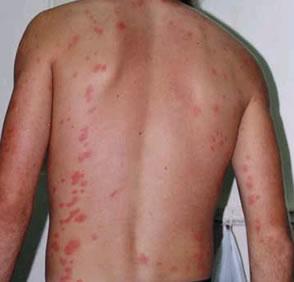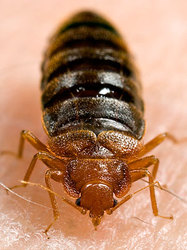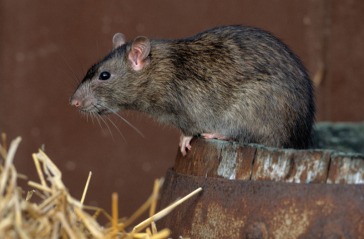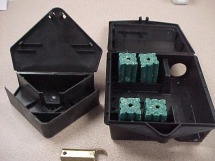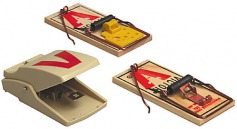Coral Springs Pest Control by PestPolice911
Roaches, Ants, Bed Bugs, Palmetto Bugs, Rodents, Fleas, Ticks, Critter Control... we cover it all Guaranteed!
About How We Deal with Each type of Pest"Lets us Solve Your Problem!" Pest Police 911
|
|
|
TicksWe service the interior and exterior of your home including lawn (if applicable). We use two different insecticides, one which is initially more potent for a quick knock down of existing bugs and one that continues to kill bugs for up to 60 days. We also use an insect growth regulator which sterilizes any flea/tick that comes into contact with our spray so they cannot lay eggs before expiring from the insecticides, as the bugs do not die instantly when they come into contact with the spray. We have found this formulation to be effective for wiping out the existing population of fleas/ticks while leaving a residual that will eliminate new bugs as they hatch, migrate or are carried onto your property by transfer on person, item or animal. A follow up treatment is usually necessary between 10-14 days after the initial treatment. All animals must be treated to receive a 60 day guarantee. The host animal(s) and the environment must be maintained on schedule to prevent the issue from reoccurring. We recommend 7-8 weeks after your clean out service that you have us perform your first preventative service and then to stay on schedule every 7-8 weeks to have continual protection against a future infestation. For more info... |
|
|
Bed Bugs
A bedbug pierces the skin of its host with two hollow feeding tubes shaped like tongues. With
one tube it injects its saliva, which contains anticoagulant's & anesthetics, while with
the other it withdraws the blood of its host. After feeding for about five minutes, the bug
returns to its hiding place. It takes between five to ten minutes for a bedbug to become
completely engorged with blood. Although bedbugs can live for a year without feeding, they
normally try to feed every five to ten days. In cold weather, bedbugs can live for about a
year; at temperatures more conducive to activity and feeding, about 5 months. Bedbugs can
survive a wide range of temperatures and atmospheric compositions. Below 61.0 °F, adults enter
semi-hibernation and can survive longer. The thermal death point for Cimex lectularius is high:
113 °F, and all stages of life are killed by 7 minutes of exposure to 115 °F
Bed bug cases require a thorough investigation and treatment of the entire home. Moderate to severe cases may require the removal of infested furniture to help eradicate the problem in a timely manner. In most cases the mattress, box springs, bed frame, sofa or recliner are the most heavily infested areas and the source of the problem. The bugs prefer to remain as close to their host as possible. When the population begins to grow is when you generally begin to find them along the ceiling lines, in the curtains, behind pictures on the wall, etc. If no particular item is heavily infested, it is not necessary to discard any furniture. Whether you buy a new mattress and box spring or keep your current ones, we always recommend mattress covers for the mattress and box spring. The covers must seal completely. We keep abreast with the latest research and industry standards for materials and methods regarding all pest management issues, including bed bugs. The chemicals we use are non-toxic and odorless. They kill bed bugs when sprayed directly as well as residually for up to 60 days. However, since bed bugs are chemically resistant, they do not die instantly when they come into contact with the spray, it takes repeated exposure. Due to this fact, we never promise instant results, as it is rarely a possibility. If any exterminator is promising you instant and lasting results, or an extremely low price for treating a bed bug problem, I would recommend that you do your due diligence in researching the credibility of the company and the treatment options they offer. We actually encourage customers to explore all the treatment options available for themselves (Heat, Cryogenics, Tenting, Canine Detection, Steam, etc.), to do their own research and make an informed decision. Be sure to read the pros and cons of each particular type of service. With our service, each treatment and each passing week you will notice a decline in the number of bugs found, dead or alive. Any live bugs found after we begin service at your location, we refer to as 'Dead Bugs Walking', as they have already come into contact with our spray but it has yet to have it's full effect. The amount of time it will take for your problem to be completely eliminated depends largely on the severity of the infestation and the level of cooperation from you as the customer. Most mild to moderate cases, with reasonable customer cooperation will be eradicated within 3 weeks to 3 months. We realize that this is a broad time frame but each situation is unique, we would be happy to discuss your particular situation in greater detail and give you reasonable expectations. Your first bed bug treatment includes a secondary follow up visit between 10-14 days after the initial visit. We prefer to strip the bedding ourselves and thoroughly inspect as we do so on these first two treatments in order to gauge the severity of the case. Any subsequent treatments we request that you have the bedding removed prior to our arrival, this saves us time and allows us to charge less for subsequent treatments. What can you do to help? Your bedding should be washed with hot water and dried on high heat at least once a week. Items that cannot be put into the washer can be put in the dryer on high heat for 40 minutes. After your follow up visit, we recommend that you utilize our services Monthly for a minimum of 3 months, then Bi-Monthly for an additional year to ensure that the problem is completely eliminated. The reason for this, is that bed bugs can live for an extended period of time, up to 18 months, without feeding. We want to make sure we get each and every bug. We have successfully provided hundreds of customers with bed bug services in our area. Through these experiences we have curtailed our treatment approach to be as highly effective, yet cost-efficient as possible. |
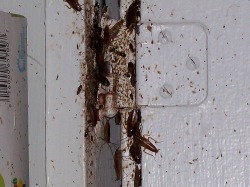 |
The German Cockroachis one of the most common and prominent household cockroaches in the world. It can be tan/brown to almost black, and has two dark parallel streaks running from the head to the base of the wings. Although it has wings, it is unable to fly. The German cockroach is very successful at establishing an ecological niche in buildings, and is very resilient against attempts at pest control. This is because of the large number of nymphs produced from each egg case, the short period between birth and sexual maturity, and their ability to easily hide due to their small size. They prefer to nest around cabinetry and behind major appliances. |
|
|
Rats
|
ANTS
The most common pest problem that homeowners in South Florida encounter is ants. Since each variety of ant exhibits different social behavior and nesting preferences, we have tailored separate strategic solutions for each individual kind of ant found in our service area. The first step is for us to identify the type of ant problem(s) you have at your location, then treat your home accordingly. We treat the interior and exterior of the home to eliminate the current problem while protecting your home from any future pest problems. The chemicals we use inside are non-toxic, odorless and will not stain walls, baseboards, floors or furniture. After we service your home you will receive a 60 day bug free guarantee. For certain types of ants such as Carpenter Ants and White-Footed Black Ants, it is recommended to treat the attic of your home, as this is their preferred nesting space. This does require an additional charge.
What Type of Ants do you have?
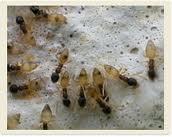 |
Pharaoh Ants / Sugar AntsCommonly referred to as Sugar Ants, Ghost Ants or Piss Ants(excuse our French, but this seems to be a common nickname for these little guys, since they are commonly found in bathrooms). These are the very tiny light brown colored ant you find around your kitchen/bathroom sink, on the counters and in the pantry. Although they are the smallest ant around, if left unchecked they can become a huge aggravation. |
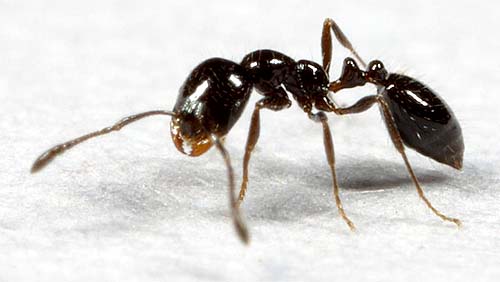 |
Pavement Ants / Crazy AntsAlso referred to as Crazy Ants or Black Ants. These are also a medium sized black ant. At first glance they look similar to the White Footed Black Ant. But upon further inspection you will find that their movements are much faster and more erratic (hence the name 'Crazy Ants'). They do not travel in straight line trails and are generally found, well, on the pavement, usually on your driveway, walkway, porch, deck or sidewalk. |
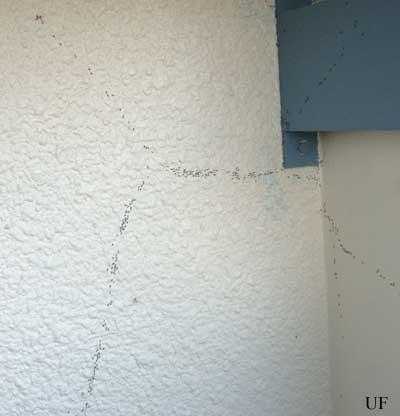 |
White Footed Black AntsCommonly referred to as Black Ants. |
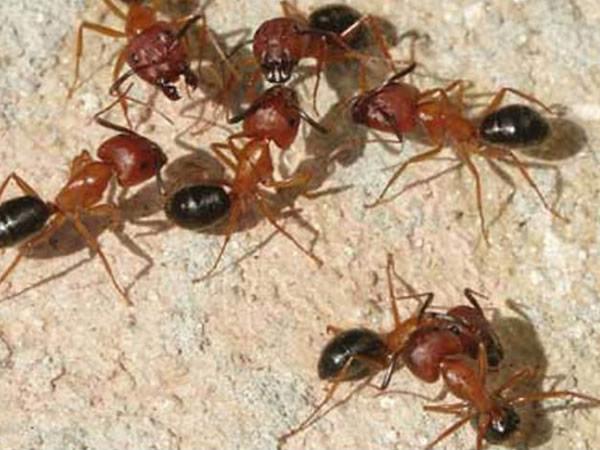 |
Carpenter AntsCommonly referred to as Red Ants or Bull
Ants.
|
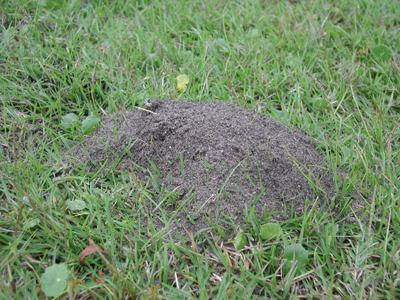 |
Fire AntsAlso referred to as Red Ants, we also put 'Big Headed Ants' in this same category, as they are very similar and the treatment methods are identical. These are a smaller, subterranean red ant. They are known for their painful bite. These are the ones who build piles of sand in your backyard or kick up sand through the cracks in your driveway and sidewalk. They commonly have heavy trails leading from the ground, up into an entry point on the exterior wall. Many times it is at the hose bib or where cable lines pierce the shell of the structure and have not been properly sealed. Once inside they usually become visible crawling around near the baseboards, and if you own a pet, these are generally the culprits going after the dog or cat food. |

|



